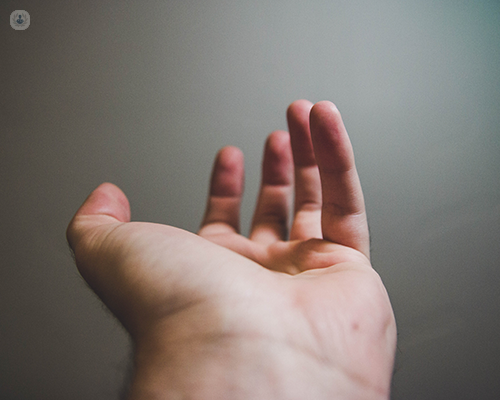Trigger finger symptoms and treatment
Escrito por:Trigger finger can occur in any fingers or the thumb. You might have mild symptoms or you might have quite inconvenient ones that impact the functionality of your hand. Mr Andrew Logan is a highly-experienced orthopaedic surgeon who specialises in this condition. After reading his explanation on trigger finger, you’ll have a clear understanding of the condition, symptoms and available treatment.

What is trigger finger?
Trigger finger is likened to the mechanism of firing a gun. When the trigger of a gun is squeezed, nothing happens until you reach a certain point of pressure on the trigger - at that point, the gun will suddenly fire. The term “trigger finger” is where a finger gets stuck down after making a fist. When the person tries to straighten that finger nothing will happen and then suddenly, the finger will release and straighten.
What are the symptoms of trigger finger?
It can occur in any finger or the thumb. In its milder form, there is clicking and catching of the finger as it is bent and straightened. In more severe cases, the finger can get stuck in the palm when making a fist. It will then release painfully and suddenly or the other hand has to be used to try to straighten that finger. There can also be pain and tenderness in the palm at the base of the affected finger.
Why does trigger finger happen?
Tendons in the fingers run in tunnels and the entrance to these tunnels is at the base of the finger in the palm. The tunnel entrance can thicken and rub on the tendon, causing swelling on part of the tendon. When making a fist, the swelling on the tendon is pulled out of the tunnel. The swelling gets stuck on the entrance, stopping the finger from straightening. If there is enough force, the swelling will suddenly ‘pop’ into to the entrance of the tunnel and the finger will jerk out straight. Once the swelling is in the tunnel, the tendon is able to move freely until it pops out the tunnel entrance and the finger gets stuck again.
Who is most at risk?
It occurs in around 2% of the population. The people most at risk are ladies in their 50’s or 60’s and there is an increased risk if you have diabetes. It is a rare condition in children’s fingers where the cause of the triggering can be slightly different than in adults. If a child has a trigger digit, it is most likely to be the thumb that is affected. In this case, the thumb rarely clicks or is painful but the child is not fully able to straighten the end joint of the thumb.
Are there any home remedies for trigger finger?
Resting the tendon by splinting the finger straight at night can improve the symptoms in the daytime. This may be enough to reduce the swelling in the tendon with time.
When is treatment necessary?
If the trigger finger is painful and inconvenient, then it is worth considering treatment.
What are the treatment options?
Night splinting, as previously mentioned, can be enough to reduce the swelling. Steroid injections can cure the condition in up to two-thirds of patients.
Operation under local anaesthetic is reserved for patients where there is a recurrence of symptoms following a steroid injection and if a repeat injection does not seem worthwhile. The tunnel entrance can be released by cutting the entrance to the tunnel with a needle into the palm (percutaneous technique). More commonly, it is done with a small cut in the palm and the entrance to the tunnel is divided under direct vision. The long-term success rate following surgery is very high.
Trigger finger is one of Mr Andrew Logan’s specialities. Don’t hesitate in contacting him to learn more and receive help - click here.


